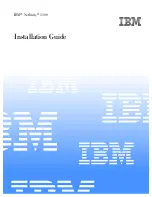
You can use the ASU under any supported operating system, or you can use the Bootable Media Creator or
a Windows- or Linux-based toolkit to create bootable media that contains the ASU. For information about
the Advanced Settings Utility (ASU), see the
Advanced Settings Utility User's Guide
and instructions for
downloading and unpacking the ASU code at
https://support.lenovo.com/solutions/LNVO-ASU
For instructions for updating the UUID and DMI/SMBIOS data, using the different methods for accessing the
IMM, see “Locally: Keyboard Controller Style (KCS)” on page 141, “Locally: LAN over USB” on page 141,
and “Remotely over a LAN” on page 142. The following conventions apply to the command syntax:
• Variables are shown in
italics
.
• Optional parameters are enclosed in brackets ([ ]). Do not type the brackets in the commands. If you omit
an optional parameter, the default is used.
• Although the command syntax is shown in mixed case, the commands are not case sensitive.
Locally: Keyboard Controller Style (KCS)
This topic provides instructions on how to update the Universal Unique Identifier and DMI/SMBIOS data on
the server locally using the Keyboard Controller Style (KCS) method.
This access method uses the IPMI/KCS interface. The IPMI driver must be installed; with some operating
systems, the IPMI driver is installed by default. The Advanced Settings Utility (ASU) provides the
corresponding mapping layer.
To update the UUID, in the ASU command-line interface, enter the following command:
asu set SYSTEM_PROD_DATA.SysInfoUUID
uuid
where
uuid
is the user-assigned hexadecimal value, up to 16 bytes, that identifies the server.
To update the DMI/SMBIOS data, complete the following steps:
Step 1. In the ASU command-line interface, enter the following command:
asu set SYSTEM_PROD_DATA.SysInfoProdName
xxxxyyy
where:
xxxx
is the 4-digit machine type of the server.
yyy
is the 3-digit model number of the server.
Step 2. Enter the following command:
asu set SYSTEM_PROD_DATA.SysInfoSerialNum
zzzzzzz
where
zzzzzzz
is the 7-character serial number of the server.
Step 3. Enter the following command:
asu set SYSTEM_PROD_DATA.SysEncloseAssetTag
aaaaaaaaaaaaaaaaaaaaaaaaaaaaaaaaa
where
aaaaaaaaaaaaaaaaaaaaaaaaaaaaaaaaa
is the 33-character asset tag number of the server.
Locally: LAN over USB
This topic provides instructions on how to update the Universal Unique Identifier and DMI/SMBIOS data on
the server locally using LAN over USB.
To update the UUID, in the ASU command-line interface, enter the following command:
Note:
If you omit any optional parameter, the default value is used. If one or more default values are used
and the ASU cannot access the IMM by using the LAN over USB access method, the ASU automatically
uses the KCS access method.
Configuration information and instructions
141
Summary of Contents for 6241
Page 1: ...System x3850 X6 and x3950 X6 Installation and Service Guide Machine Type 6241 ...
Page 6: ...iv System x3850 X6 and x3950 X6 Installation and Service Guide ...
Page 56: ...42 System x3850 X6 and x3950 X6 Installation and Service Guide ...
Page 82: ...68 System x3850 X6 and x3950 X6 Installation and Service Guide ...
Page 132: ...118 System x3850 X6 and x3950 X6 Installation and Service Guide ...
Page 158: ...144 System x3850 X6 and x3950 X6 Installation and Service Guide ...
Page 214: ...200 System x3850 X6 and x3950 X6 Installation and Service Guide ...
Page 358: ...344 System x3850 X6 and x3950 X6 Installation and Service Guide ...
Page 1938: ...1924 System x3850 X6 and x3950 X6 Installation and Service Guide ...
Page 1964: ...1950 System x3850 X6 and x3950 X6 Installation and Service Guide ...
Page 1968: ...1954 System x3850 X6 and x3950 X6 Installation and Service Guide ...
Page 1975: ...Taiwan Class A compliance statement Appendix F Notices 1961 ...
Page 1976: ...Taiwan BSMI RoHS declaration 1962 System x3850 X6 and x3950 X6 Installation and Service Guide ...
Page 1988: ...1974 System x3850 X6 and x3950 X6 Installation and Service Guide ...
Page 1989: ......
Page 1990: ......
















































